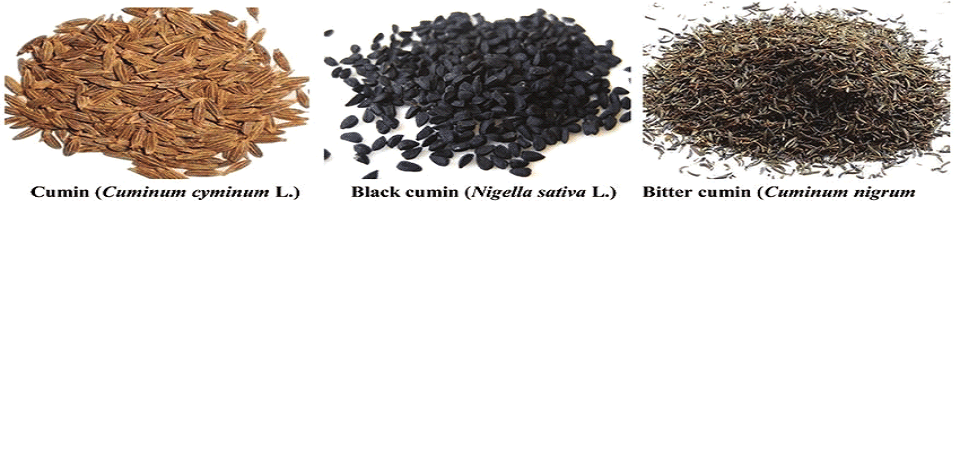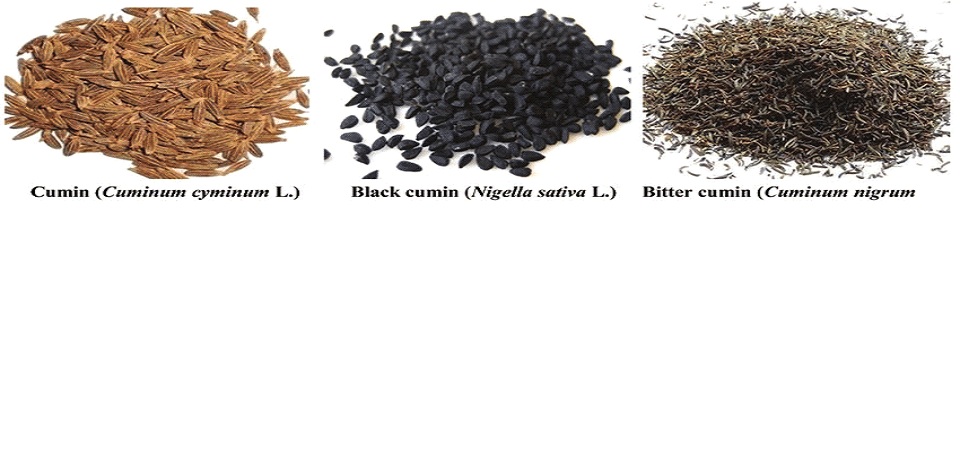CUMIN DEFINITION, VARIETIES, TRADITIONAL USES & ITS EFFECTS ON HEALTH
ABSTRACT
This species of multipurpose plant, which is part of the Apiaceae family, is grown throughout the Mediterranean region, the Middle East, China, and India. The market-available cumin is made up of a blend of distinct mericarps. This is a commonly used spice and food additive in everyday cooking. Many diseases, including cancer, respiratory issues, metabolic syndrome, diabetes, lipidemia, obesity, and other conditions, are treated with cumin in traditional medicine. It is also used as a stimulant and an analgesic. Included in this article are active components like flavonoids, phenols, and terpenes that contribute to cumin’s biological and medical characteristics. Because of its high phenolic content and strong antioxidant activity, cumin can be added to food for preservation as well as nutritional benefits.

INTRODUCTION
Cumin (Cumininum Cyminum) is a strong aromatic herb; its dried seed is used as a spice. Cumin or Zeera is the common name in India, and it is also known as Kummel, Commino, Kemon, and Zira elsewhere. Cumin is indigenous to Egypt (upper Nile Valley) , the Mediterranean region, Iran, and India. Now it is also cultivated in Mediterranean countries (India, Iran, Turkey, Mexico, Japan, and China). It is an easily available herb and is less expensive as compared to black pepper.
Antioxidants such as phenolics, flavonoids, and coumarins are present. It is identified that more antioxidant components are present in the roots, stem, leaves, and flowers, such as gamma-terpinene, alpha-terpinene, and bornyl acetate, respectively. The major phenolic compound, quercetin, is found in the roots, while in stems and leaves, p-coumaric, rosmarinic, and trans-2-hydroxycinnamic acids are present. These constituents are examined by phytochemical and quantitative tests with DPPH radical scavenging activity. With the preparation of aqueous and alcoholic extracts, the antioxidant activities are determined. There are mainly three varieties of cumin: Cuminum cyminum, black cumin (Nigella sativa), and bitter cumin (Cuminum nigrum). Among these, the highest phenolic content is found in bitter cumin. For cumin essential oil, a hexane extract is prepared, which shows high antioxidant activity. Nigella sativa contains protein, fats, carbohydrates, crude fiber, and total ash. Cu, P, Zn, and Fe are present in good amounts. Carvone, limolene, citronellol in trace amounts, and two varieties of alkaloids: isoquinoline (nigellicimine) and pyrazole alkaloid (nigellidine). also contains a water-soluble pentacyclic triterpene, i.e., alpha-hederin. It is also rich in unsaturated fatty acids like oleic acid (20%) and linoleic acid. (50%–60%). The main constituent of oil is thymoquinonone (TQ). whereas bitter cumin seeds contain traces of calcium, vitamin A, potassium, and Na, and essential oils include limonene, carvone, and p-cymene. Studies found that cumin is used for multiple purposes and is beneficial to health, particularly in diabetes, hypertension, respiratory disorders, neuroprotective, and hepatoprotective activities. Black cumin is mainly used for medicinal purposes, as it can help treat immune disorders.
VARIETIES OF CUMIN, ITS CONSTITUENTS, AND THEIR TRADITIONAL USES ARE SHOWN BELOW IN THE TABLE
| Cuminum Cyminum | Cuminum Nigrum |
 |  |
| Called As Zeera | Kashmiri Jeera/ or Shahijeera |
| Cuminaldehyde | Cuminaldehyde, p-mentha- 1, 3-dien-7-al |
| The seeds of cumin have been used in cuisine in every part of World for ages. Used to treat chronic diarrhoea, dyspepsia, and other traditional medicinal uses. | A spice used in daily household cooking in Northern India. |
CHEMICAL AND NUTRITIVE CONSTITUENTS OF CUMIN
They provide a high amount of fat (monounsaturated), protein, and dietary fibre. Vitamin B and E are dietary minerals. Iron is also considerable in cumin seeds. The major volatile components of cumin are cuminaldehyde, cymene, and terpenoids. Its strong aroma is due to the essential oil content, i.e., cuminaldehyde and cuminic alcohol.
AROMATIC COMPOUNDS IN CUMIN ARE

HEALTH EFFECTS OF CUMIN
Though cumin is not only an aromatic spice herb, it also plays an important role in traditional medicine to treat a variety of disorders, including chronic diarrhoea , dyspepsia, acute gastritis, diabetes, and cancer. Its biological and bioactive constituents, such as terpenes, phenols, and flavonoids, showed various health effects.
- Antidiabetic
- Dyspepsia
- Digestive Stimulant
- Anti-inflammatory
- Antioxidant
- Cardioprotective, neuroprotective, and chemopreventive
1. Antidiabetics Effect
For diabetics, cumin in the form of ground powder may be helpful in controlling blood sugar. This may also contribute to the maintenance of reduced cholesterol or LDL (low-density lipoprotein) levels. Diabetes mellitus and hyperlipidemia are related as well. The consumption of cumin orally has been shown to decrease triglycerides, phospholipids, free fatty acids, plasma and tissue cholesterol, and body weight. The reduction of hyperglycemia and glycosuria is one of the benefits of cumin powder. Comparing cuminaldehyde to acarbose and quercetin, the former is 1.8 and the latter is 1.6 times less effective in inhibiting action. However, cuminaldehyde has a place in antidiabetic medications.
2. Anti-inflammatory Effect
Through the inhibition of protein kinase, constituents of cumin essential oil (TQ) stimulate cells and have anti-inflammatory properties. Proinflammatory enzymes and cytokines are the targets of the radical-scavenging activity, which is directed towards inflammation. The anti-osteoporotic effects of TQ and N. sativa on human health are demonstrated by the suppression of inflammatory cytokines (interleukin-1 and 6) and transcription factors (NF-kb). This is true even though oxidative stress and inflammation are linked to osteoporosis.The expression of various pro-inflammatory cytokines and chemokines is responsible for the anti-inflammatory action observed in PDA (Pancreatic Ductal Adenocarcinoma) cells.
3. Antioxidant Activity
Cumin oil has strong antioxidant activity because it contains flavonoids, linalool, carvacrol, anethol, estragol, and other polyphenolic compounds. It also contains monoterpene alcohols. Antioxidants have the ability to counteract free radicals, which are unstable particles that cause damage to cells. Diseases like cancer, heart disease, and high blood pressure can be avoided with the aid of this antioxidant. Because black cumin contains terpenoids, flavonoids, tannins, and alkaloids, it is also regarded as a medicinal spice and an excellent natural antioxidant.
4. Digestive Stimulant
Cumin seeds aid in stimulating digestive enzymes and are used in both conventional medicine and home remedies. Direct oral intake of cumin with water helps lower the gastric. Pancreatic lipase activity is decreased by dietary cumin, but the activity of other enzymes such as pancreatic trypsin, chymotrypsin, and amylase is increased. When cumin is consumed orally during a fast, postprandial blood sugar decreases.
5. Antimicrobial
Cumin oils and extracts have the potential to be antimicrobial. Antibacterial activity is demonstrated by certain pathogenic and beneficial gram-positive and gram-negative bacterial strains. Klebsiella pneumoniae is inhibited from growing by alcoholic extract and cumin seed oil. clinically isolated and lead to reduced urease activity, improved capsule expression, and improved cell morphology. This feature of cuminaldehyde is demonstrated. Biofilm formation against Streptococcus mutans and Streptococcus pyogenes.
Researchers look into the antifungal activity of various substances against human, animal, food, and soil pathogens, such as yeasts, aflatoxins, dermatophytes, and Vibrio spp.
6. Immunomodulatory
It has been demonstrated that the oral dose-dependent modulation of T lymphocyte expression has immunomodulatory qualities. It stimulates T lymphocytes (CD-4 and CD-8) The active form of cumin offset the depleted T lymphocytes and mitigated the increased weight of the spleen and thymus as well as the enlarged adrenal glands and elevated corticosterone levels.
7. Gastrointestinal
The different extracts of cumin, aqueous and alcoholic, show increased activities of the gut enzymes amylase, protease, lipase, and phytase. Its ability to scavenge free radicals and have a flavonoid content have been associated with its confirmed antiulcerogenic activity. Along with chronic gastritis and gastric carcinoma, H. pylori is recognized as the primary etiological factor linked to the development of gastritis and peptic ulcer disease.
Aside from that, cumin extract prevents the aggregation of collagen and adrenaline. Platelet count and Hb concentration were both elevated by cumin oil, while WBC count was decreased. Thus, the LDL and HDL cholesterol ratios are also lowered in this case.
8. Anti-obesity
One of the best herbs for weight loss is cumin, which is added to meals to reduce fat cells. On an empty stomach, consuming Jeera water first thing in the morning can support weight loss and reduction efforts. Depending on each individual’s body, too much jeera can occasionally be extremely harmful. Individuals who are at risk for hypoglycemia should be aware of the risks associated with drinking water
Excessive consumption of cumin
Cumin’s detrimental effect is that it slows blood clotting, which may have an impact on bleeding disorders. This could make it more difficult to control blood sugar levels and exacerbate bleeding during surgery. Therefore, refrain from consuming cumin for at least two weeks prior to the planned surgery. It can damage the kidneys and liver because cumin oil is highly unstable. The potential of black cumin and its essential component, thymoquinone, to prevent kidney damage has been studied. Because cumin contains narcotic properties as well, it should be used with caution. Its adverse effects include nausea, drowsiness, and mental fogging. Cumin seeds may result in significant bleeding during the menstrual cycle. Allergies may result from this, and using cumin may irritate skin and cause rashes. Jeera water should also not be consumed by those who are allergic to spices.
Conclusion
The article’s overall conclusion is that a potent, aromatic spice used in regular meals is having a bigger influence on medicinal and biological effects. There are hundreds of benefits to cumin, all of which were covered above. In addition to helping with other gastrointestinal issues, it improved the drug’s bioavailability and other biodynamic properties like anti-inflammatory, anti-diabetic, and immunomodulatory effects. The majority of N. sativa seeds’ therapeutic qualities as well as the pharmacological potential of black cumin N. sativa seeds, their oil, and other volatile oil constituents were verified by scientific research. Additionally, it assisted in managing weight loss. Since antiobesity is the primary cause of all disorders, drinking jeera water first thing in the morning is essential for maintaining a healthy body weight. Both the quantitative test and the phytochemical analysis have been completed. As was previously mentioned, the metabolites alkaloids, flavonoids, and polyphenols are verified in a variety of seed extracts (methanolic and aqueous).
Dr. Vikram Chauhan
Latest posts by Dr. Vikram Chauhan (see all)
- ALTERNATIVE AYURVEDIC TREATMENT FOR CHRONIC KIDNEY DISEASE - July 24, 2024
- Ayurvedic Treatment for Liver Disease with Herbal Remedies - July 22, 2024
- Ayurvedic Treatment For Diabetes Mellitus With Herbal Remedies - July 4, 2024
- Ayurvedic Aspect Of Liver And Management Of Liver Diseases - July 3, 2024
- Natural Ayurvedic Treatment For Fibromyalgia With Herbal Remedies - July 2, 2024




